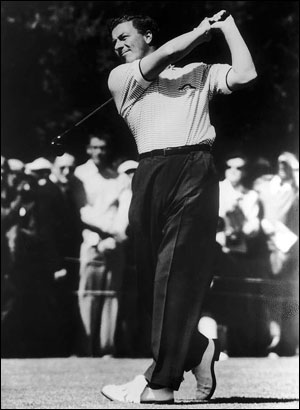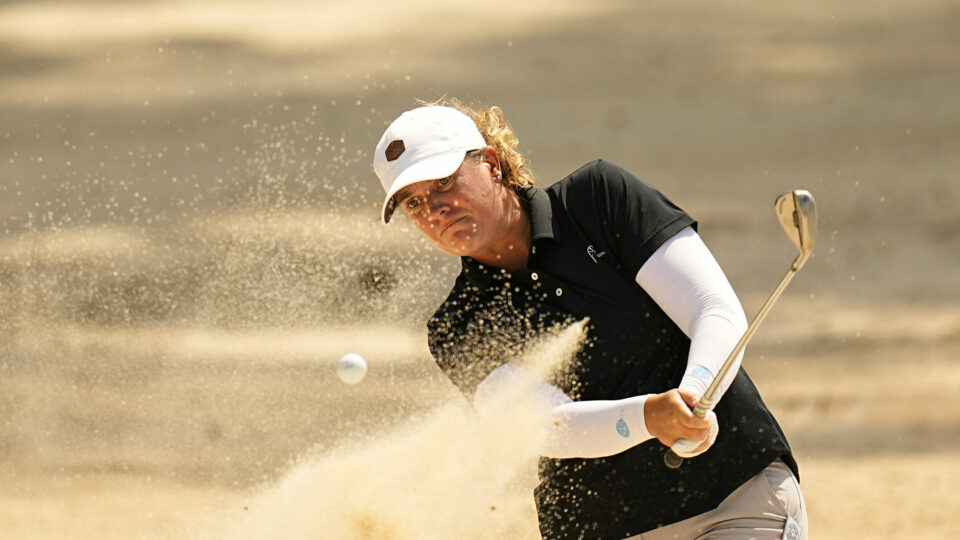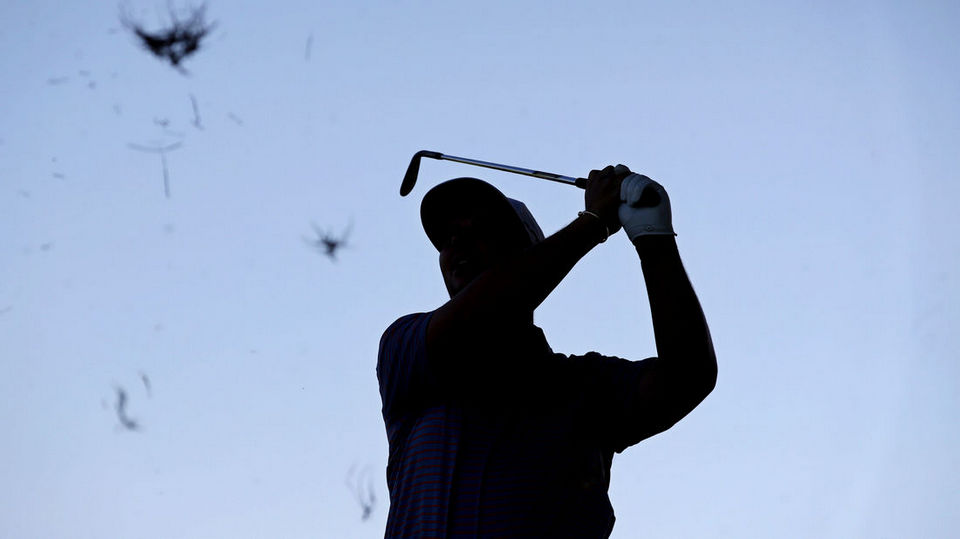19th Hole
Nightmare Among the mighty
- Ian Fleming
The author recounts the personal drama of playing in the Bowmaker Invitation Amateur/Professional Tournament at the Berkshire Golf Club, in June 1957. The following is the article as it first ran in the Sunday TImes the following week, with Fleming later remarking that it "appears to have stirred the bowels of most amateur golfers."
Every sport has its own nightmare – the dropped baton, the goal scored against your own side, running out your captain when he has scored ninety nine; and, in your dreams they all have the same ghastly background – the packed stands, the serried ranks of spectators, the incredulous hush and then the deep condemnatory groan.
In golf the two-foot putt missed on the 18th green is quickly over and you are at once awake, sweating and whimpering. This terror must be common to even the greatest in the game, but for the weekend golfer there is a far longer, more horrible nightmare – partnership with a world champion over a course black with crowds.
Last weekend I endured this nightmare, thirty-six holes of it and I live, but only just, to tell the tale.
It came about like this. Three weeks ago a friend said he wanted me to play in the Bowmaker Invitation Amateur/Professional Tournament at the Berkshire. “It's great fun,” he said. “All the best professionals take two amateurs each and you play a threesome against bogey. Each team puts in three cards – the professional's for the best scratch score and the professional plus each amateur for the lowest better ball score. The amateur plays off full handicap and if he makes good use of his strokes he and his pro can get a better ball score around 60. You can pick up when you've played too many. They have film stars and such like to amuse the crowds. Come on.”

It sounded fun. I said “yes” and forgot all about it.
I forgot about it until I got the draw. I was to play with Peter Thomson, three times Open champion, and Alec Shepperson, handicap plus 1, a Walker Cup probable. I was to be on the first tee of the Red Course at 2.15 pm last Sunday.
That was Tuesday the eighteenth. On the Wednesday, Peer Thomson, fresh from the fine performance in the American Open, equalled the course record of Sand Moor with a 65 in the Yorkshire Evening News Tournament. He followed this with a 67, 64 and 65. He won the tournament by fifteen strokes. The golfing world gasped.
Apart from praying that the biggest thunderstorm in living memory would deluge the home counties on the following Sunday and Monday (it was a two day contest) there was really nothing I could do about it. I am a nine handicap weekend golfer with a short flat swing that has been likened to a housemaid sweeping under a bed. It is a fast swing with reserves of fantastic acceleration in moments of stress.
The only reason I am nine is that I obstinately try to play down to it rather than take life more easily off twelve, which I should like to be.
I have never had a golf lesson except from my grandmother at the age of about fifteen and my only equipment for the game is a natural ‘eye' and strong forearms. Against these virtues it should it be said that I remember to keep my head down only on one shot in-three and that, on occasional shots, ‘everything moves except the ball'.
The greatest weakness of my essentially immaculate game is that I am quite unable to ‘repeat' my swing. Even on the putting green, my stance and stroke are at the mercy of the moment's whim. The fact that I have played golf for some thirty years with occasional success and great pleasure is due to enjoying the company, the exercise and the zest of competition. In short, I am the quintessential amateur.
The virtues of amateurishness are all right in a friendly game, perhaps sharpened by a gamble, in the privacy of one's home course. There the quick, sharp dunch into a bunker is a matter for hilarity only mildly tinged with bitterness. But how, I wondered feverishly as the dreadful day approached, would my insouciance stand up to playing before vast crowds with the greatest, or at any rate the second greatest golfer in the world?
But why worry? It's only a game. The ball won't move. Just walk up and hit it. These and other specious exhortations were mouthed at me through wolfish grins by my friends. The worst you can do is maim a few spectators, perhaps even kill one. But the club will be insured. Have a double kummel before you start. Take an Oblivion.
Steeled by the relish of my friends. I assumed a nonchalant mask. I looked to my equipment. The head of my driver (circa 1930, one of the earliest surely, of the steel shafts and known around Sandwich as “Excalibur”) was loose. I had it fixed. My double-faced chipper (Tom Morris, 1935), a beloved but temperamental club was rebound. I bought two pairs of expensive socks in pale blue. I reread the red ink passages in Armour's How to Play Your Best Golf All The Time, watched Peter Thomson's unearthly progress through the “Yorkshire Evening News” tournament and waited queasily for H – (for Horror) Day.
H-DAY dawned bright and clear. No earthquakes. No tornadoes. No thunderstorms. I drove at an even pace to the Berkshire, parked my car among the hundreds, and proceeded to the seventh fairway of the Blue Course, which a number of young gods were bisecting with arrow-straight drives and iron shot using mounds of practice balls.
I retired to an inconspicuous corner with my caddie, six balls and No. 3 Iron. It took me about twenty minutes, in my usual ratio of one good shot in three, to lose four of the balls in the woods.
Then came lunch and the un-welcome news that the matches were running over an hour late, I wandered out among the dreadful trappings of my nightmare – the marquees, the huge scoreboard ablaze with the most famous names in professional and amateur golf, and already showing the results of the early starters and in the background, the loudspeaker giving the position on the near-by 17th tee.
Henry Cotton passed me, his face a mask of concentration, and Locke, majestic, indomitable. Henry Longhurst tossed me a few phrases of gleeful commiseration. And then there were Peter Thomson and Alec Shepperson and I was explaining who I was and apologising in advance for the dreadful things that they would be shortly witnessing. For the first time I felt a ray of comfort. All golfers have their problems. Shepperson was a candidate for the Walker Cup team and he knew the names would be announced the next day and that the selectors were on the course. Thomson knew that every spectator would expect him to go round in level threes. We commiserated with one another over the swelling crowds and in due course there we were standing on the first tee.

The starter's voice rang out – unnecessarily loudly. Thomson drove 250 yards down the centre of the fairway.
“Mr Iarn [sic] Fleming.”
I wiped my hands on the seat of my trousers and stepped forward. Half conscious, I teed up and gave a practice swing, listening with half my mind for the hiss of astonishment. The crowd was too well bred. I addressed the ball and promptly knocked it off its peg. I put it on again.
Then there was a moment when the world stood still, a brief glimpse of the ball through a mist of tears, a more of less articulated swirl of motion and the blessed ball was well airborne and on its way with a slight draw to come to rest in the rough fifty yards behind Thomson's.
Shepperson hit a beauty and we were off and away with the crowd streaming after us. One of my chief tortures easily foreseen was that I should always be playing first of the trio, I hacked the ball out of the shallow heather and got it 100 yards on its way down the fairway. Thomson pushed his to the right of the green. Shepperson fluffed with a 4-wood and there I was having to hit mine again.
I had a stroke at all the odd holes. Now it was vital that I should hit the simplest of simple shots 150 yards on the green. I took out my blaster with which I thought I would be safest. There was a respectful hush. Head down, you fool! Slow back! BOING!!! The ball hit off the sole, whizzed along the ground, bumbled up the green and stopped within three yards of the pin.
Muttering something about “Dundee run-up” I strode after it and, to cut a long story short, both Thomson and Shepperson got fives and all I had to do was to get down in two putts to win a net 4 for Thomson and our better ball. I putted, or rather twitched, the ball a yard past, missing the hole by three inches. Then, with a thumping heart, stroked, or more accurately topped, the ball into the hole amid heartfelt applause from the agonised crowd.
I will pass over the second hole where I hit a No 7 over the green and picked up and where Thomson got an immaculate 3.

I forget what happened at the 4th but at the par three 5th, having been advised by Thomson to take a 7 instead of a 8, I at last hit the ball in the middle of the bat and got a net two which I followed up with another net two, also well played, at the 7th. Again at the 9th, but this time again by foul means, I scrambled a net four. I had helped Peter Thomson five times in nine holes!
Those treacherous crocodiles my friends, who had come to gloat at my discomfiture changed their tune. Now they edged up and whispered that my handicap would have to be reduced at Sandwich. I brushed them aside. The sun was shining, the course was beautiful. What fun it was playing with the Open Champion!
Alas, while by dunch, scuffle and fluff I somehow played the next nine holes. I was no further help to Peter Thomson and all I can remember of the inward half is the most glorious three I have ever seen, by Shepperson at the bogey five 15th and an appalling shank by myself at the 17th. It was with a No. 8 off a downhill lie and the air positively quivered with the horrible clang as the ball sped at right angles through the spectators' legs into the deep rough.
And then the round was over with a score of 72 for Peter Thomson and net 66s for Alec Shepperson and myself. No earthly good but at least I hadn't played Thomson's ball by mistake or done an air shot or killed a spectator. It was in a mood of euphoria that I returned to London.
Monday was not so good and I did many terrible things that even now makes me shudder, but it had rained very heavily and there were fewer witnesses. Thomson did a 69 and Shepperson who by this time had been nominated for the Walker Cup and I, repeated our 66s which meant that at least I had been able to help Thomson on the three holes.
And now the dreadful glory of the occasion is fading and this weekend I shall be applying either a new kind of golf, tempered to the finest steel by its visit to the blast furnace, or more probably, wilted by the fierce flame.
Alas, when my friends or my grandchildren ask me how Peter Thomson played this shot or Alec Shepperson that, I shall be unable to tell them. I shall have many memories of the two men – of Peter Thomson, justly renowned for a bearing as fine as his golf and of the modest, charming Shepperson – but of the champion's golf I shall recall nothing but the immortal words of Leonard Crawley in last Monday's Daily Telegraph.
“Though Peter Thomson was assisted by Ian Fleming, the champion had evidently spent much of his force at Leeds last week”.
ALEC SHEPPERSON REMEMBERS...
Fleming's amateur partner that week, the former Walker Cup player, Alec Shepperson, is now President of Coxmoor Golf Club which he joined in 1945, aged nine.
“I remember being delighted to be asked to play in the inaugural Bowmaker in such illustrious company. Peter Thomson had already won a hat trick of Open championships, and I had read some of the early James Bond books.
I was still at Oxford taking my finals that summer, but had played for England in the 1956 Home Internationals, had won the President's Putter at Rye and was, as the article explains, selected that very week for the forthcoming Walker Cup matches in Minneapolis. I still have the telegram from Raymond Oppenheimer, the chairman of the selectors.
I do remember the first tee at the Berkshire very well, meeting them both and the starter pronouncing Ian's name “Iarn”!
I also remember Ian smoking during the round, with his trademark cigarette holder very much in evidence! It was a very pleasant two days, and I was fascinated how Peter Thomson teed the ball very high and struck it “on the up” with his driver, explaining how less spin and a higher trajectory gave him more distance. It was the first time I'd seen anyone with that technique. The Walker Cup, a few weeks later, was memorable – although I only played one match, with Guy Wolstenhome [Gary's father] when we halved our 36-hole foursomes.
My highlight of that era was probably the Walker Cup of 1959 when I played with Michael Lunt against Jack Nicklaus & Ward Wettlaufer in a see-saw match that we eventually lost 2&1.The next I day I won my singles against Tommy Aaron by the same margin, having been 4 down with 9 to play.”
Editor's note: In 1957 Coxmoor Golf Club became the only club in the country to supply two players for the same Walker Cup team when Alec Shepperson and Alan Bussell were both picked. Oliver Wilson was the latest Coxmoor player to be selected for the Walker Cup when he was chosen for the 2003 match at Ganton.
Reproduced with kind permission of Golf International.



